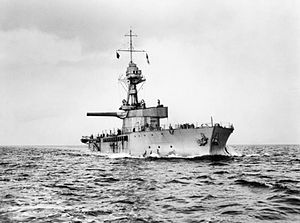Marshal Ney-class monitor

Marshal Ney with guns trained to starboard
|
|
| Class overview | |
|---|---|
| Name: | Marshal Ney class |
| Builders: | Palmers Shipbuilding and Iron Company |
| Operators: |
|
| In service: | 1915–1957 |
| In commission: | 1915 |
| Completed: | 2 |
| General characteristics | |
| Type: | Monitor |
| Displacement: |
|
| Length: | 355 ft (108 m) |
| Beam: | 90 ft (27 m) |
| Draught: | 10 ft 5 in (3.18 m) |
| Propulsion: | Diesel engines (MAN for Ney, Vickers for Soult), 2 shafts, 1,500 hp |
| Speed: |
|
| Complement: | 187 |
| Armament: |
|
| Armour: |
|
The Marshal Ney class was a class of monitor built for the Royal Navy during the First World War.
The need for monitors for shelling enemy positions from the English Channel had become apparent only at the start of the war and they were designed with some haste. The design of monitors had been given by the Director of Naval Construction, Eustace Tennyson d'Eyncourt, to the Assistant Constructor, Charles S. Lillicrap (later himself to become Director). By the time the Marshal Neys came about some 33 monitors of various sorts had already been ordered. The redesign of the battlecruisers Renown and Repulse meant that there were now two modern 15-inch turrets available. The First Sea Lord Jackie Fisher and Winston Churchill, First Lord of the Admiralty decided these should be used for two more monitors, initially M 13 and M 14, but then renamed after the French Napoleonic War marshals Nicolas Jean de Dieu Soult and Michel Ney.
For machinery the two monitors received diesel engines, which were then a novelty – the majority of ships being steam powered. The use of diesels meant that they had no need of boiler rooms which went well with a low draught, nor of large funnels which reduced the amount of superstructure. These engines were originally designed for much smaller freighters and therefore they proved particularly slow and unreliable.
...
Wikipedia
